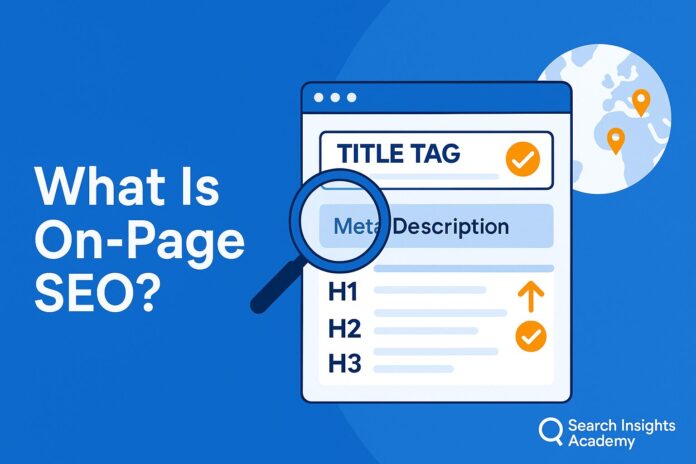Have you ever wondered how some web pages manage to appear right at the top of Google’s results for searches like “on-page SEO” or “what is meta tag description”? Do you feel like your own website could do better in terms of visibility? Or maybe you’ve tried tweaking your title tags or meta descriptions but haven’t seen the improvements you expected?
In this blog post, we’ll break down the essentials of on-page search engine optimisation (often called “on-page SEO”). We’ll explore how to find meta tags on a website, craft engaging title tags, write click-worthy meta descriptions, and use headers properly. Together, these elements form the backbone of a strong SEO strategy that works regardless of whether you’re in Sydney, San Francisco, or Singapore.
By the end, you’ll have a clear roadmap for elevating your site’s position in searches. You’ll learn specific tips, see practical examples, and discover helpful tools that can guide you along the way. Let’s get started and make sure your website stands out for all the right reasons.
Introduction: Why On-Page SEO Matters
Defining On-Page SEO: Key Elements and Benefits
On-page SEO describes the process of refining the content, structure, and HTML elements of your web page to make it more attractive to both users and search engines. This includes adding the right keywords, improving readability, and ensuring the site loads quickly. According to a study by Semrush, pages with optimized on-page elements rank significantly higher than those without proper optimization.
When done well, on-page search engine optimisation allows your site to appear more relevant to your target audience. Whether you operate a local café in Melbourne or an e-commerce store with global reach, the same principles apply. By focusing on the critical elements—like the title tag, meta description, and well-structured headers—you create a strong foundation for your SEO strategy that can work in any market.
Understanding the Difference Between On-Page and Off-Page SEO
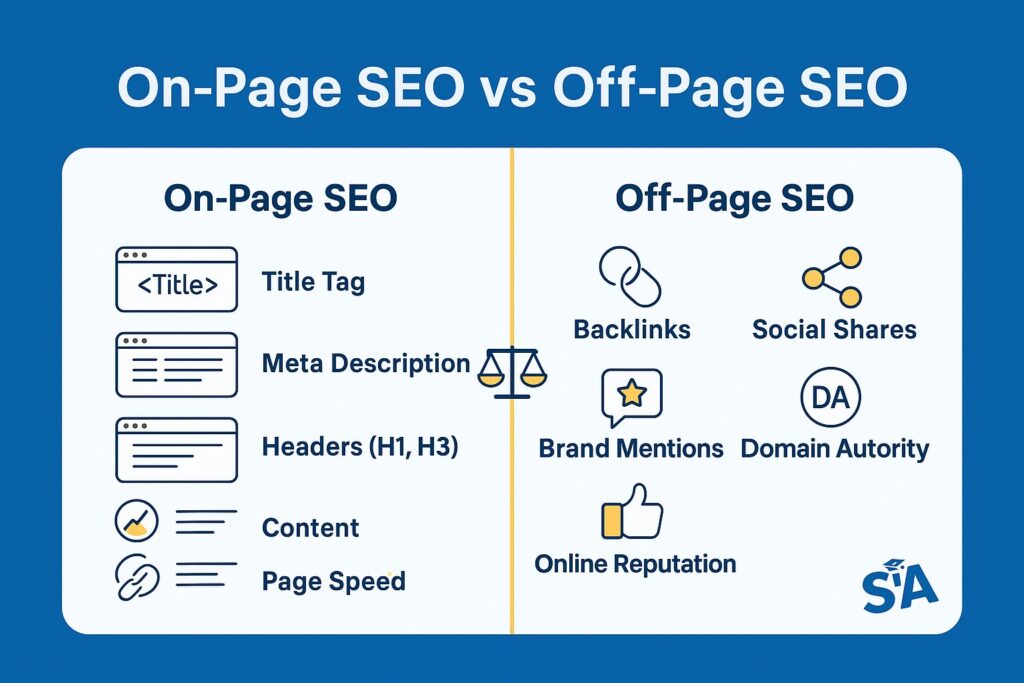
On-page SEO covers everything within your direct control: keywords in your content, the URL structure, how fast your pages load, and the formatting of important tags. Off-page SEO, on the other hand, deals with external factors like backlinks from other websites, social media mentions, and brand authority. Moz’s Beginner’s Guide to SEO offers an excellent explanation of how these two approaches complement each other.
Think of on-page SEO as the engine under your car’s hood, while off-page SEO is the network of roads connecting various brands and audiences. Balancing both is key. A top-notch link-building strategy can help, but if your on-page elements are poorly optimized, you might still struggle to rank highly. That’s why refining your on-page approach is such a core part of any search engine optimization strategy.
Identifying Pain Points: Common Mistakes and Missed Opportunities
Many website owners simply forget to use proper headings or to research their target keywords. Others overlook the importance of updating their title tags with relevant terms. Additionally, some fail to set up their meta descriptions properly, leading to less impactful listings in search results. Search Engine Journal identifies that poorly optimized title tags and meta descriptions are among the top mistakes that hurt rankings.
Even if you catch these errors, you might be neglecting tools that can give you a quick win—like a title tag checker or an on-page SEO analysis tool. By fixing these mistakes, you can stand out from competitors who haven’t fine-tuned their on-page SEO. Simple changes, such as using descriptive page descriptions, can have a big impact on your click-through rates and search rankings.
Title Tags: Making a Strong First Impression
What Is Website Title? The Role of Title Tags in SEO
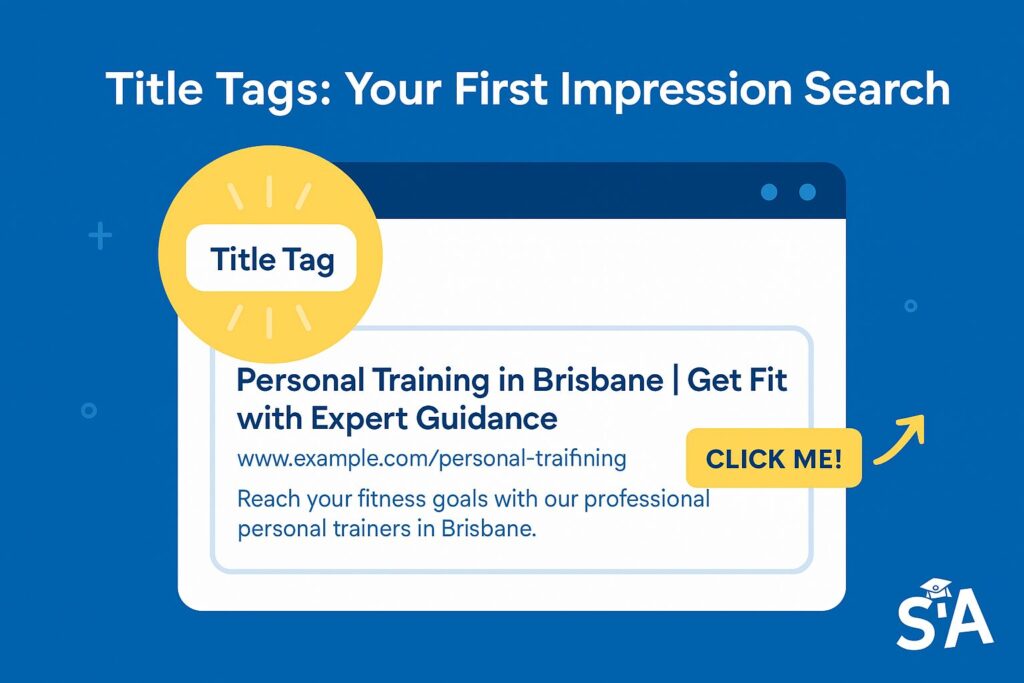
The “website title,” also known as the title tag, is the brief text shown in the browser tab and in search results. It’s how search engines and visitors identify the topic of your page at first glance. Google’s SEO Starter Guide emphasizes that a good title tag should accurately describe your page’s content while enticing users to click. In many cases, it doubles as your best shot at making a lasting first impression before people even land on your page.
For example, if you run a fitness studio offering personal training, you might use a title like “Personal Training – Get Fit with Expert Guidance.” This clarifies what you do and why users should choose you. If you’re targeting local traffic, adding your location (like “Personal Training in Brisbane”) can help attract nearby customers.
How to Find Meta Tags on a Website: Practical Steps for Title Tag Check
If you’re not sure what your current title tag says, it’s easy to figure it out. Simply open your browser, visit your webpage, and look at the top of the window. Alternatively, check the page’s source code by right-clicking and selecting “View Page Source,” then search for “<title>”. Ahrefs provides a comprehensive guide on how to audit these elements.
Tools like Screaming Frog can also help by auditing your pages and suggesting improvements. One big plus of performing these checks is that you can see if your title tag is too long or vague. Poorly written titles often get truncated in search results, which can lower click-through rates. By updating your title accordingly, you ensure that the entire message shows up in search results for potential visitors.
Title Length Checker: Ensuring Optimal Title Tag Length

Title length checkers are handy tools for verifying if your title tag meets recommended character limits. Typically, search engines truncate anything beyond 50–60 characters. Search Engine Land notes that keeping titles under this limit ensures they display properly in search results. If you exceed it, you’ll want to edit your title. A precise, engaging title will look better in search results and stand a higher chance of attracting clicks.
Be sure to include relevant keywords—like “on-page SEO” or “search engine optimisation”—where possible. Just avoid stuffing them in unnaturally. The goal is to match user intent while still reading smoothly.
Title Tag Best Practices: Incorporating Local and Global Examples
One best practice is to place your main keyword at the start of your title, followed by a secondary keyword if it fits naturally. For businesses targeting specific regions, consider including the city or state, especially if you serve a specific area. For instance, “On-Page SEO Services in Sydney | Boost Your Website’s Visibility” signals your location and service right away.
Also, keep your language straightforward. HubSpot’s research shows people prefer simple titles that clearly explain the page’s subject matter. Throwing in brand names can help too, but only if you have room. Think of the title tag as your first handshake with the visitor—firm, concise, and memorable.
Title Tag in Content Management Systems: Customising Your Title in Wix
If you’re hosting your site on Wix, customising your title is a breeze. In the Wix Editor, open up your page settings, and you’ll see a section for SEO. There, you can type in an exact title tag, ensure it’s not too long, and test it against any relevant tools. Wix’s own SEO guide provides detailed instructions on managing these elements.
Similar processes exist for WordPress with plugins like Yoast SEO or Shopify through their built-in SEO features. Once you’ve updated, do a fresh title tag check to confirm everything is formatted correctly. Remember, small adjustments can mean the difference between a user scrolling by and a user clicking through.
Changing Site Title: A Quick How-To
Sometimes you’ll need to update your overall site title if you rebrand or shift focus. In most content management systems, this can be done through the site settings area. For example, in WordPress, you’d navigate to Settings > General. WordPress’s documentation explains how to make these changes.
Once you’ve made this change, be sure to fill out each page’s unique title and meta description as well. One of the most common mistakes is forgetting to differentiate pages, resulting in duplicate title tags that confuse visitors and search engines alike. Keep your brand name front-and-center without sacrificing a descriptive, keyword-rich page title.
Meta Descriptions: Encouraging Click-Throughs
What Is Meta Tag Description? Understanding Its Purpose
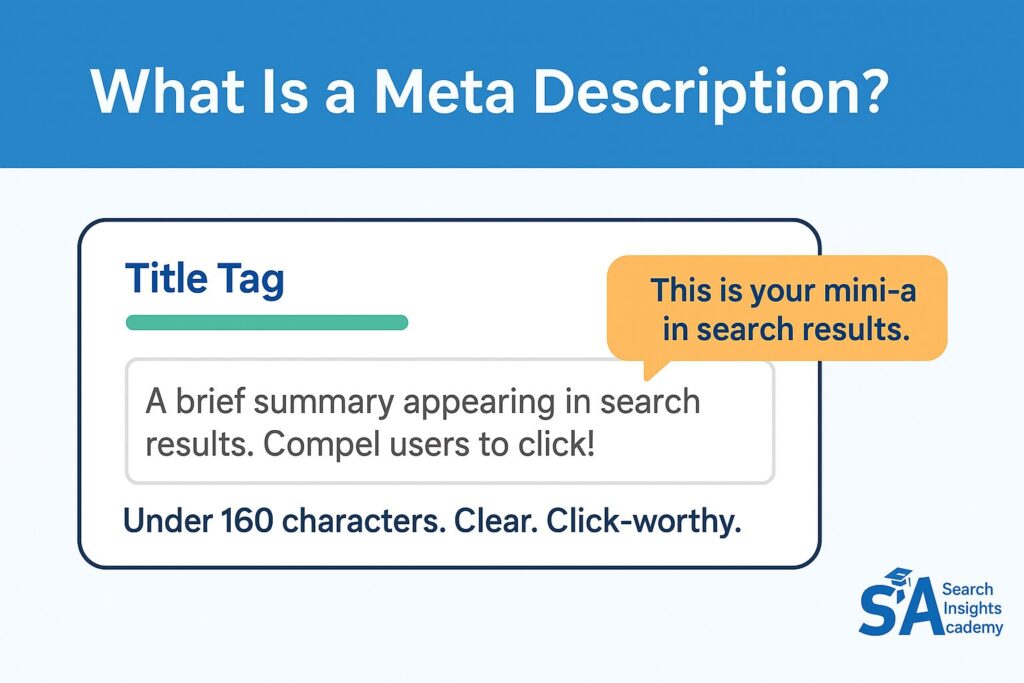
The meta description is a short snippet that appears below your title in search results. When someone searches “meta descriptions,” this snippet can either convince them to click or make them look elsewhere. So, it’s not just about summarizing content—it’s about turning casual searchers into intrigued visitors.
These brief summaries should typically stay under 160 characters. Search Engine Watch advises that if they’re too long, they’ll be cut off in search results. On the other hand, if they’re too vague or repetitive, you could miss out on connecting with your audience. A perfect meta description sets the stage for what users can expect, bridging the gap between search intent and your content.
Meta Description Tag: Why It Impacts Your Search Engine Ranking
While the meta description tag itself isn’t always a direct ranking factor, it can indirectly impact your SEO performance by influencing click-through rates (CTR). When people see a compelling description that includes relevant keywords, they’re more likely to click. That’s a positive signal to search engines. Backlinko’s analysis shows that over time, a higher CTR can help you climb the rankings.
In addition, the meta description tag helps you align your page’s message with user expectations. If someone types in “SEO web page best practices,” sees your snippet mentioning on-page SEO tips for businesses, and clicks through because that’s what they need, you’ve successfully attracted the right audience. And hopefully, they’ll stay to read your page in full.
Tools for Crafting Engaging Descriptions
Crafting an engaging description can be easier with the help of dedicated SEO tools. Platforms like SEMrush or Ahrefs offer insights on length, relevance, and even suggestions for better wording. You can test different snippets to see which might perform best. Just keep your brand voice in mind, especially if you cater to a specific audience.
Aim to include at least one main keyword in the description. For instance, if your keyword is “on-page SEO services,” weave it in naturally: “Looking to improve your on-page SEO services? We specialize in boosting traffic and online presence for businesses worldwide.” This approach tells potential visitors they’re in the right place.
Setting Up Meta Descriptions in Various Platforms
When setting up your description in content management systems like Wix, WordPress, or Shopify, the process is generally straightforward. In most platforms, you’ll find a dedicated SEO section where you can add your meta description. WordPress SEO by Yoast makes this particularly easy by providing a preview of how your snippet will appear in search results.
Don’t be afraid to include compelling phrases that speak to your audience. For example, “Award-winning coffee shop—our café’s fresh brews are waiting for you. Discover everything from lattes to cold drip coffee on our menu!” Such a snippet speaks directly to coffee lovers, whether they’re in Perth, Portland, or Paris.
SEO Page Description: Aligning Keywords with User Intent
A good SEO page description focuses on the user’s intent. Write it from the visitor’s perspective. If someone searches “best beaches,” they probably want a quick overview of top coastal spots. So, your meta description could read, “Explore breathtaking beaches—from hidden coves to popular sunbathing spots. Plan your perfect getaway with our comprehensive guide.”
Nielsen Norman Group research shows that aligning your description with what users expect to find after clicking is crucial. That way, you cut down on the bounce rate, and search engines recognize your page’s relevance. Plus, you earn trust from visitors who appreciate you answering their question right away.
Avoiding Pitfalls: Common Meta Description Mistakes
Many people forget to customize the meta description for each page, leaving the same generic snippet across the site. Others cram in too many keywords, making it read like a shopping list. Search Engine Journal points out that this puts off real visitors, which can negatively affect your engagement metrics.
Another pitfall is using vague or clickbait-like descriptions that don’t match the actual page content. If visitors arrive expecting something else, they’ll bounce fast, hurting your SEO efforts. Finally, watch your character count. Anything beyond 160 characters may get truncated, meaning users miss some of your text. Aim for clarity and keep an eye on the length for each page’s listing.
Headers (H1, H2, H3…): Structuring Your Content
Why Headers Are Crucial for On-Page Search Engine Optimisation
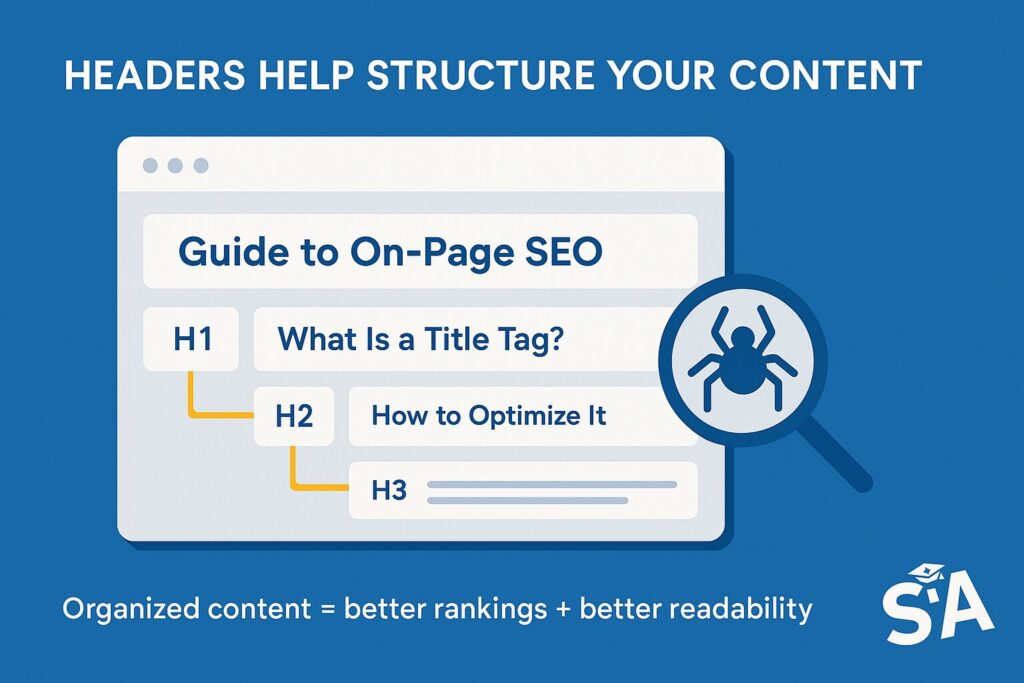
Headers, also known as heading tags (H1, H2, H3, and so on), help shape the structure of your content. They act like signposts, guiding readers and search engines through sections. Content Marketing Institute explains that clear, descriptive headers also reveal the main topics on your page, helping search engines confirm that your content aligns with the title and meta description. This alignment is key for effective on-page SEO optimization.
For instance, if your H2 headers address topics like “how to find meta tags on a website” or “SEO fields in content management systems,” it’s logical for your paragraphs to expand on those points. This way, search engines recognize that your page is relevant to these queries, enhancing your chances of reaching the right audience.
Writing Headers for Readability and SEO
Using subheadings benefits both your readers and your rankings. Readers can quickly skim and decide which section is most relevant to them. Meanwhile, search engines can parse the headings, linking them to specific queries like “SEO on-page best practices” or “what is meta tag description.” Orbit Media’s content study confirms that placing targeted keywords in your headers often pays off.
However, make sure your wording feels natural. Avoid stuffing keywords into the headings just for the sake of it. If you’re discussing “on-page search engine optimisation” for businesses, frame it in a straightforward manner. Use a header like “Why On-Page Search Engine Optimisation Matters for Your Business.” This approach is both welcoming and clear.
Managing Header Tags in Content Management Systems
If you’re using a platform like Contentful, WordPress, or Wix to manage content, you’ll find dedicated fields for header tags. These fields let you define critical elements like titles and headings. WordPress’s block editor makes it easy to create different heading levels with a few clicks.
In many CMS platforms, you can also preview how your content appears. Take advantage of this feature to confirm your heading structure is logical. Each heading should flow logically from one idea to the next, helping visitors and crawlers navigate your site stress-free. Webflow’s guide offers useful tips on proper heading structure.
Maintaining Consistency: Aligning Headers with Title and Meta Tags
Your page’s title, header tags, and meta description should tell a cohesive story. If your title promises “Best Seafood Restaurants,” make sure there’s at least one section with an H2 heading that expands on that promise, like “Top Seafood Spots to Visit.” Then, your meta description should summarize this content too.
Google’s E-A-T guidelines suggest that consistency solidifies user trust. People reading your snippet in search results expect the page to talk about that subject. If your headers deviate wildly, they’ll feel misled and leave. So as you plan or review your headers, ask yourself if they reflect the core message and keywords found in your title tag and meta description. If they do, it’s a good sign you’re on track.
Integrating and Optimising On-Page SEO
Keyword Research: Finding Low-Hanging Fruit for Titles and Descriptions
A vital step in on-page search engine optimization is keyword research. Look for “low-hanging fruit” keywords—phrases that have decent search volume but aren’t overly competitive. Ahrefs’ keyword research guide suggests this approach works well for businesses of all sizes, from Australian brands to global corporations.
Tools like Google Keyword Planner help identify potential terms. Once you’ve found them, inject them into your title tags and meta descriptions. You might also incorporate them naturally into subheadings and paragraphs. Balancing keywords with readability ensures your content speaks to both search engines and real people.
Visualising On-Page SEO Optimisation
Sometimes a visual aid, like an on-page SEO infographic, helps you see the bigger picture. Infographics can outline where to place your keyword (in the title, meta descriptions, and headers) and even highlight the ideal word count or structure. Search Engine Journal’s visual guide offers a comprehensive look at these elements.
If you’re not a graphic designer, don’t worry. There are free tools like Canva that let you piece together simple infographics. Show important stats, best practices, and step-by-step guides. Then embed it into your blog post so readers can grasp on-page SEO more quickly. It’s a neat way of giving them something memorable to take away from your site.
Balancing User Experience and SEO on Your Web Page
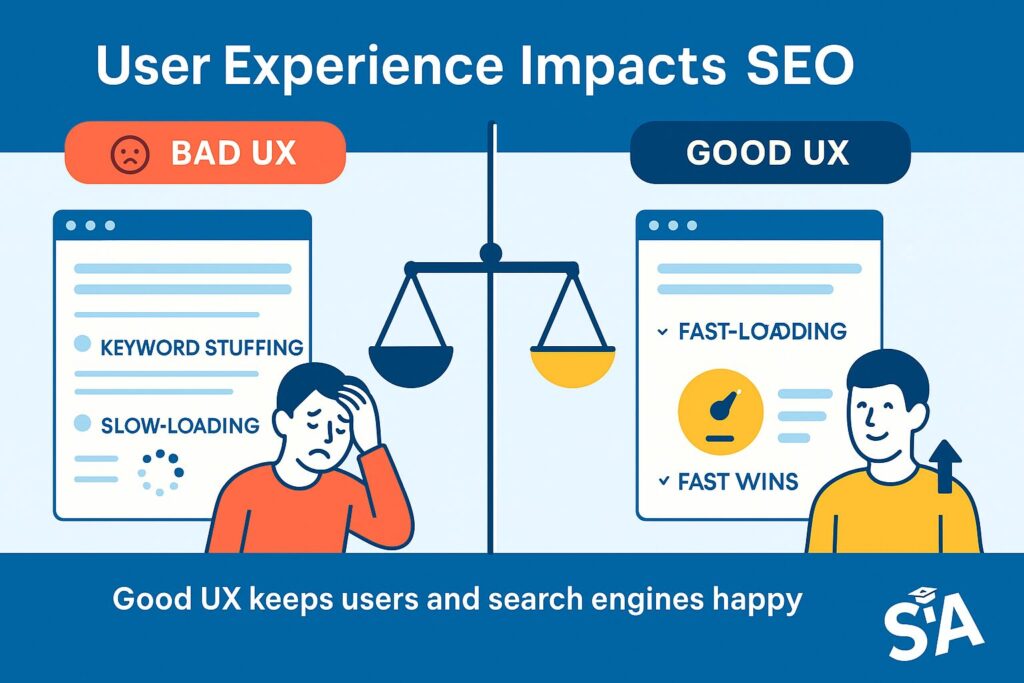
While SEO is crucial, never forget about user experience (UX). If your page is stuffed with keywords or crammed with awkward headings, visitors won’t stay for long. Nielsen Norman Group research shows that an appealing format, short paragraphs, and clean navigation help readers enjoy your content. Tools that measure readability—like the Hemingway Editor—suggest if your text is too complex.
Another part of UX involves page speed. A slow-loading page can negate the benefits of great title tags or meta descriptions. Google’s PageSpeed Insights can help ensure your page loads quickly. In today’s market, people often browse on mobile devices, so a snappy mobile experience is key for retaining visitors and reducing bounce rates, whether they’re in Sydney, Seattle, or Stockholm.
When to Seek Professional Help
There comes a point when you might want professional assistance. Perhaps time constraints keep you from diving into the details, or maybe you need advanced strategies to compete in a crowded marketplace. That’s where professional SEO services can help. Experts provide audits, do thorough keyword research, and refine your headings, tags, and overall structure.
Professional services can also help with advanced topics like schema markup or competitor analysis. Search Engine Land notes that if you’re serious about climbing the ranks for competitive keywords in a robust market, a seasoned agency or consultant can propel you forward. In the end, it’s about finding the right balance between in-house efforts and calling in the pros.
People Also Ask: Addressing Top Questions
How to Find Meta Tags on a Website? Step-by-Step Guide
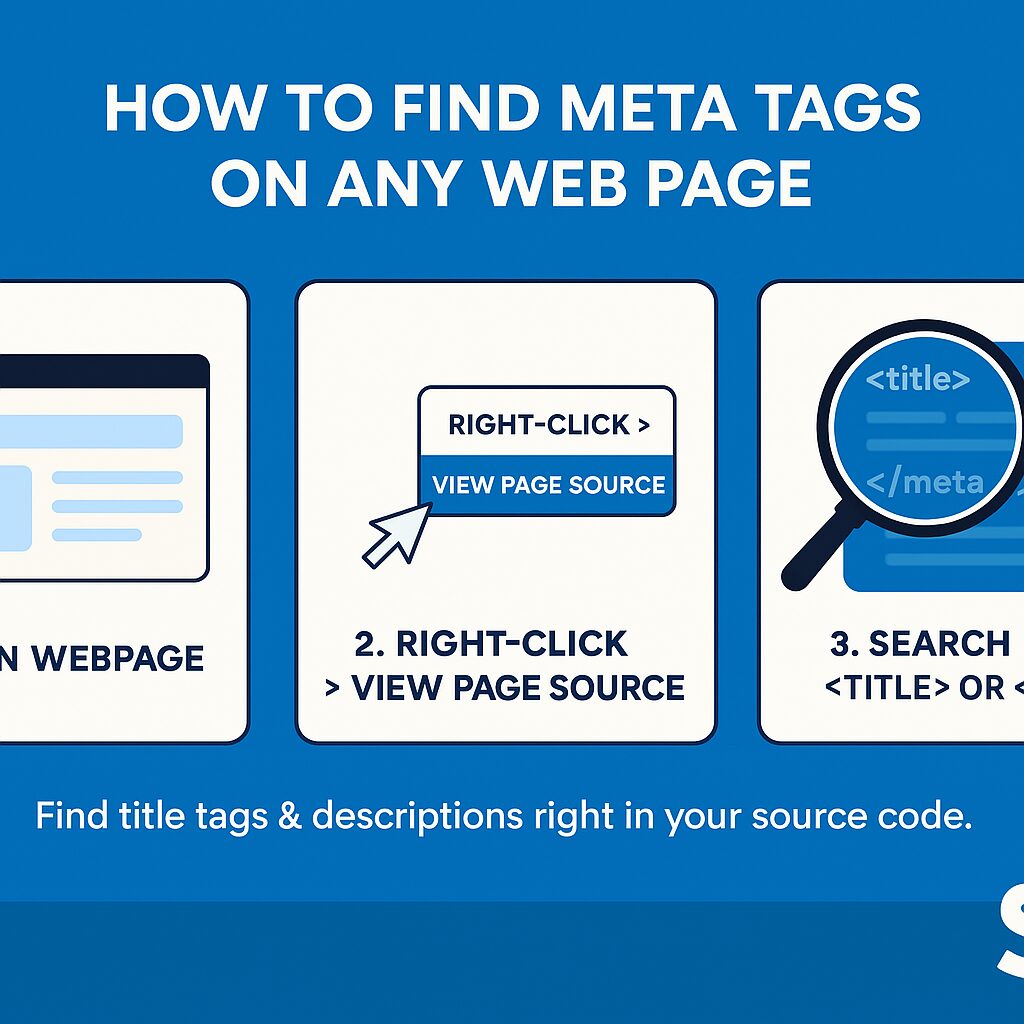
Finding meta tags, including title and meta description, is simpler than you might guess. First, open your webpage in any browser, right-click, and select “View Page Source.” Then, press “Ctrl+F” (or “Command+F” on Mac) to search for “meta.” You’ll see lines that look like <meta name=”description” content=”…”>. This is where your meta description lives. The title tag is visible between <title> and </title> in the code. Ahrefs’ technical SEO guide explains these elements in detail.
For those who prefer automated tools, browser extensions like SEO Meta in 1 Click can display this information with a single click, making the process much faster.
What Is Website Title? Importance and Best Practices
The “website title,” often referred to as the title tag, is your page’s first point of contact with potential visitors. Appearing at the top of the browser and in search results, it sets user expectations. Moz’s title tag guide explains that best practices include keeping it concise, adding relevant keywords near the start, and ensuring it’s unique for each page. This approach lets search engines and users see that you have distinct content worth exploring.
A well-crafted title tag can significantly increase your click-through rate from search results, directly impacting your traffic and potentially your rankings over time.
What Is Meta Tag Description? How It Affects Your Traffic
A “meta tag description” is the short summary that appears below your title in Google results. While it might not be a direct ranking factor, Search Engine Journal confirms it plays a pivotal role in enticing clicks. A good meta description clarifies what your page covers and why it’s valuable. This small piece of text can significantly influence user decisions, impacting your click-through rate and eventually your search rankings.
Think of your meta description as a mini-advertisement for your page. It should accurately represent your content while compelling users to click through to learn more.
Do Optimised Title Tags, Meta Descriptions, and Headers Really Boost Rankings?
Yes, balanced on-page optimisation truly can push your site higher in search results. Backlinko’s ranking factors study shows that search engines use these elements to understand what your page is about. Visitors use them to decide if your link is worth clicking. When everything aligns—keyword research, headings, meta data, and user-friendly content—you create a page that search engines are more likely to serve to the right audience. Over time, that leads to better visibility and higher rankings.
The impact may not be immediate, but consistent attention to these details builds a strong foundation for long-term SEO success.
Advanced Strategies and Tools
Going Beyond the Basics
Once you’ve nailed the fundamentals of on-page SEO, you might want to explore more advanced tactics. A comprehensive approach includes strategies like internal linking, structured data, and content clustering. Search Engine Journal’s advanced SEO guide explains how internal links connect related articles on your site, encouraging visitors to explore more content. Structured data, on the other hand, helps search engines understand the context of your content, which can lead to rich results like featured snippets.
Consider blending local references into advanced strategies when targeting specific regions. That might involve geotagging images or using schema markup to highlight local business information. These seemingly small details can enhance your online presence in regional searches, whether you’re targeting customers in Australia, America, or anywhere else.
Regional Considerations for Global Sites
Different markets have unique characteristics. You might cater to audiences who use specific spellings (e.g., “optimisation” instead of “optimization”) or references (e.g., neighborhoods rather than states). International SEO Guide by Ahrefs recommends emphasizing country-specific domains, integrating local business listings, and referencing local events or landmarks where relevant.
Keeping local perspectives in mind is powerful. For instance, if you run a tourism site focusing on a specific region, your title and meta description should reflect local terminology and experiences. This approach builds trust among native users and helps your site resonate with them on a deeper level.
Checking On-Page SEO: Tools and Page Audits
Periodic audits are an essential practice. A single title tag check can reveal if your page titles are too short, too long, or missing entirely. Tools like Screaming Frog or SEMrush give you online resources for immediate feedback. You can also run broader page audits that look at headings, keyword density, image alt tags, and more.
During a page audit, pay attention to any warnings about duplicate content or missing meta descriptions. Google Search Console can help identify these issues. Duplicate or thin content can harm your search engine performance. By routinely checking, you keep your site lean, well-optimized, and ready to attract more visitors.
Ensuring Consistency Across Your Domain
Focusing on a single web page is great, but consistency across your entire website is even better. Content Marketing Institute advises that each page should be individually optimized with relevant keywords, unique titles, and distinct meta descriptions. At the same time, all pages should fit together seamlessly. A user who navigates from one page to another should feel the same tone, brand identity, and overall level of quality.
Also, ensure your navigation menus and internal links are consistent across the domain. If someone arrives through a blog post, they shouldn’t struggle to find related content or your main products or services. The easier it is to move around your site, the better your user signals will look to search engines.
Terminology Explained: On-Page SEO Optimization vs. On-Page Search Engine Optimization
You’ll often see both phrases—”on-page SEO optimization” and “on-page search engine optimisation.” They mean essentially the same thing, focusing on refining what’s on your web page to appeal to both users and search engine crawlers. The varying terminology often comes down to regional spelling differences or personal preference. “Optimisation” is more common in Australian, British, and European English, while “optimization” might appear in American-oriented content.
Regardless of which version you use, the core principle stands: you’re making content, structure, and HTML elements as effective as possible. Search Engine Journal’s glossary explains these terms and many others that might come up during your SEO journey.
Commercial Intent and Competitive Keywords
Targeting Commercial Queries
Commercial intent keywords indicate that someone is ready to take action—sign up for a service, make a purchase, or book an appointment. For instance, when someone searches “what is meta tag description” with the goal of improving their own site, they’re likely in buying mode for SEO tools or services. Neil Patel’s guide on commercial keywords explains how targeting these queries is a smart move for businesses.
Use your title and meta description to highlight your expertise. Something like: “What Is Meta Tag Description? Learn How It Can Drive Traffic to Your Website.” This appeals to anyone ready to get hands-on with improvements, whether they’re in Auckland, Amsterdam, or Atlanta.
Securing Competitive Keywords
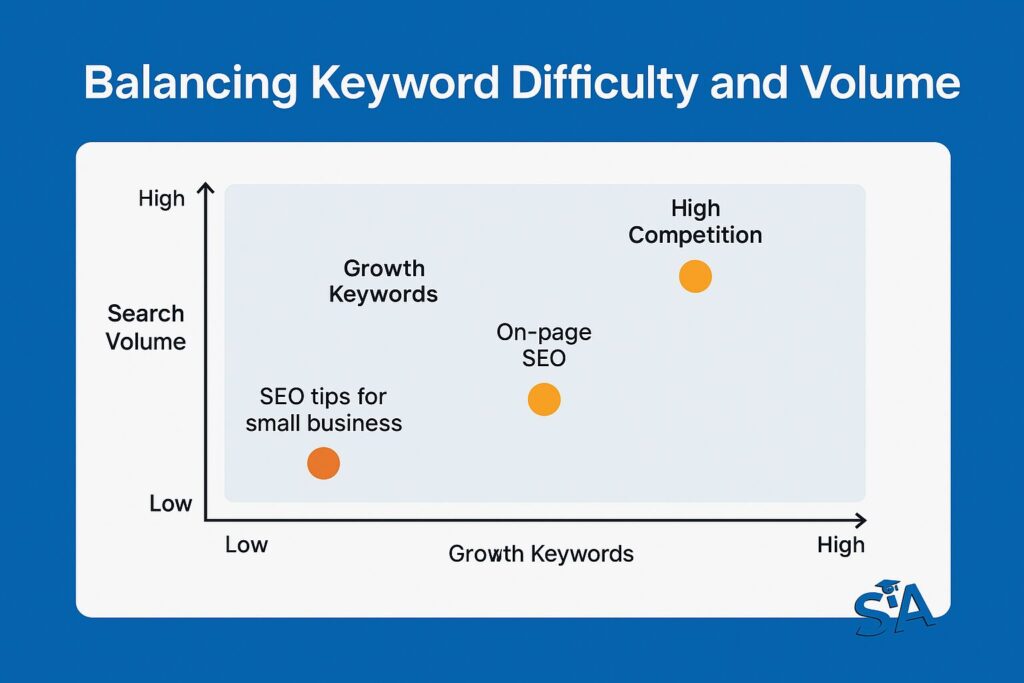
Competitive keywords like “SEO website” or “search engine optimization guide” can be tough to rank for. Still, they’re worth pursuing if they’re aligned with your goals. Moz’s competitive keyword analysis suggests creating in-depth, authoritative content that includes these phrases in your title, headers, and text. That might be a guide to SEO optimization that covers everything from advanced link-building to local citations.
Another tactic is to look for long-tail modifications of these keywords. Instead of purely “SEO website,” consider “SEO website redesign for small businesses.” While it might have lower search volume, it’ll likely attract more targeted traffic. As your domain authority grows, you can branch out to broader, more competitive terms.
Positioning Your Page SEO to Outrank Competitors
To outrank competitors, you need a well-rounded strategy. Backlinko’s competitive analysis guide recommends doing a thorough competitor analysis to see what they’re doing for their page SEO. Compare their title tags, meta descriptions, headings, and content depth. Then see where you can add more value or a unique perspective. Maybe you can share insights they’ve missed or dive deeper into statistics they’ve only skimmed over.
Additionally, keep your site updated. Search engines value fresh, relevant content. Periodically revise your pages with new data or add sections that answer trending questions. Over time, this consistent focus on improvement helps you build authority and outrank those who aren’t putting in the same effort.
Conclusion
Congratulations on making it to the end of our deep dive into on-page SEO. We’ve explored the nuts and bolts of title tags, meta descriptions, and headers, all while highlighting how a little bit of effort can lead to impressive gains in search rankings. Whether you’re a bakery in Brisbane, a designer in Delhi, or a consultant in Chicago, these principles can help your site stand out.
Before you move on, take a moment to reflect on which techniques resonate most with your goals. Maybe you’re eager to run a title tag check across your entire domain, or perhaps you want to tackle the meta descriptions you’ve been ignoring. Whatever your next step, approach it methodically. Keep track of any changes you make and observe the impact on your site’s performance.
Finally, remember that SEO isn’t a one-off task—it’s an ongoing journey. Keep testing, monitoring, and updating your pages to stay ahead of evolving search algorithms and competition. With consistent effort and the right strategies, you’ll be well on your way to unlocking higher rankings and more engaged visitors. Good luck on your SEO adventure!
Add to Conversation

